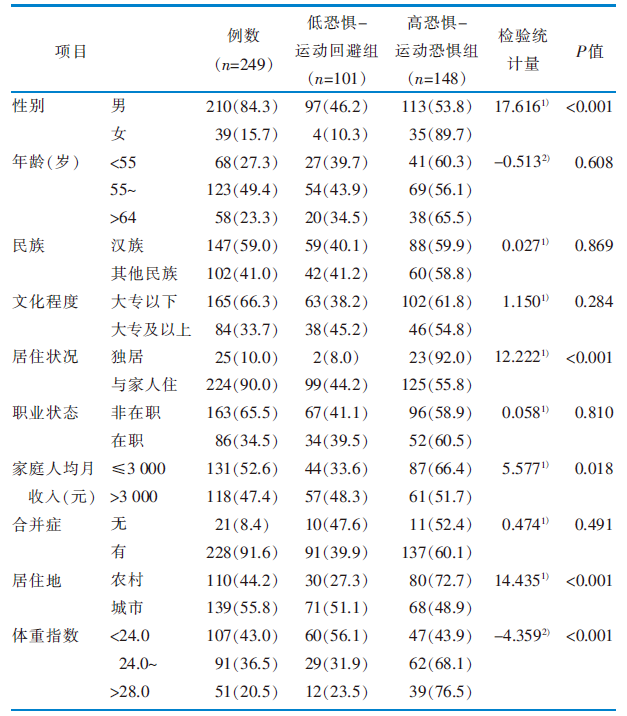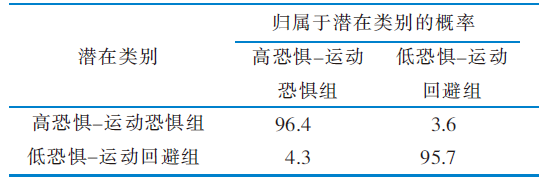


中华护理杂志 ›› 2023, Vol. 58 ›› Issue (10): 1205-1211.DOI: 10.3761/j.issn.0254-1769.2023.10.008
收稿日期:2022-09-20
出版日期:2023-05-20
发布日期:2023-05-30
通讯作者:
贲艳丽,E-mail:yueliangheliubian@163.com作者简介:张晶:女,本科(硕士在读),护师,E-mail:2055327093@qq.com
基金资助:
ZHANG Jing( ), DING Jianling, ZHANG Jiashuai, TAO Xiuxiu, BEN Yanli(
), DING Jianling, ZHANG Jiashuai, TAO Xiuxiu, BEN Yanli( )
)
Received:2022-09-20
Online:2023-05-20
Published:2023-05-30
摘要:
目的 探索冠状动脉旁路移植术(coronary artery bypass grafting,CABG)患者运动恐惧的现状并分析影响因素,为CABG患者康复运动的干预提供参考。 方法 采用方便抽样法,选取2022年1月—8月于乌鲁木齐市3所三级甲等医院就诊的CABG患者作为调查对象。于患者术后1个月,采用一般资料调查表、中文版心脏病患者运动恐惧量表、中文版多维度疲劳症状简表和锻炼行动自我效能量表进行调查。对CABG患者的运动恐惧特征进行潜在类别分析,并通过单因素分析和Logistic回归分析探索其潜在类别的影响因素。 结果 共纳入CABG患者249例,潜在类别分析拟合结果显示,CABG患者运动恐惧可分为2个潜在类别,分别命名为“高恐惧-运动恐惧组”(59.4%)和“低恐惧-运动回避组”(40.6%);Logistic回归分析结果显示,性别、体重指数、多维度疲劳症状、锻炼行动自我效能是CABG患者运动恐惧潜在类别的影响因素。 结论 CABG患者运动恐惧可分为2类。女性、体重指数≥24.0、多维度疲劳症状得分高、锻炼行动自我效能得分低的CABG患者归为“高恐惧-运动恐惧组”的概率较大。医护工作者应识别不同潜在类别CABG患者的特征及影响因素,开展个性化的干预策略以减轻CABG患者运动恐惧程度。
张晶, 丁建玲, 张家帅, 陶秀秀, 贲艳丽. 冠状动脉旁路移植术患者运动恐惧现状及影响因素分析[J]. 中华护理杂志, 2023, 58(10): 1205-1211.
ZHANG Jing, DING Jianling, ZHANG Jiashuai, TAO Xiuxiu, BEN Yanli. The status and influencing factors of kinesiophobia in patients undergoing coronary artery bypass grafting[J]. Chinese Journal of Nursing, 2023, 58(10): 1205-1211.
 |
表1 调查对象的一般资料及冠状动脉旁路移植术患者2个运动恐惧潜在类别单因素分析[例(百分比,%)]
Table 1 The general information of the subjects and single factor analysis of 2 latent classes among patients with coronary artery bypass grafting[cases(percentages,%)]
 |
 |
表3 冠状动脉旁路移植术患者运动恐惧2个潜在类别归属概率矩阵(百分率,%)
Table 3 The latent classes probability matrices for kinesiophobia in patients with coronary artery bypass grafting(percentage,%)
 |

图1 2个潜在类别在心脏疾病运动恐惧量表各条目上的条件概率分布图
Figure 1 Conditional probability distribution of 2 latent classes on each item of Tampa Scale for Kinesiophobia Heart
| [1] | 中华医学会心血管病学分会介入学组, 中华医学会心血管病学分会微循环学组, 中国老年医学学会心血管病学分会, 等. 冠状动脉旁路移植术后再次血运重建策略中国专家共识(2022版)[J]. 中华医学杂志, 2022, 102(36):2844-2853. |
| Interventional Group of Cardiovascular Society of Chinese Medical Association,Micro-circulation Group of Cardiovascular Society of Chinese Medical Association, Cardiovascular Branch of Chinese Geriatric Society, et al. China expert consensus on revascularization strategy after coronary artery bypass grafting (2022 edition)[J]. Natl Med J China, 2022, 102(36):2844-2853. | |
| [2] | 李玲, 宗玉珍, 刘遵季. 心脏术后患者运动恐惧与康复运动依从性现状及其相关性[J]. 现代临床护理, 2022, 21(6):15-19. |
| Li L, Zong YZ, Liu ZJ. Effect of kinesiophobia on exercise compliance with out-of-hospital cardiac rehabilitation in patients after cardiac surgery[J]. Mod Clin Nurs, 2022, 21(6):15-19. | |
| [3] | 刘延锦, 蔡立柏, 徐秋露, 等. 慢性疼痛患者恐动症的研究进展[J]. 中华护理杂志, 2017, 52(2):234-239. |
| Liu YJ, Cai LB, Xu QL, et al. Research progress of phobia in patients with chronic pain[J]. Chin J Nurs, 2017, 52(2):234-239. | |
| [4] | 中华护理学会老年护理专业委员会, 中国康复医学会心血管疾病预防与康复专业委员会, 中国老年保健协会脏器康复专业委员会. 心脏康复护理专家共识[J]. 中华护理杂志, 2022, 57(16):1937-1941. |
| Geriatric Nursing Committee of Chinese Nursing Association,Committee of Cardiac Rehabilitation and Prevention of Chinese Association of Rehabilitation Medicine, Organ Rehabilitation Committee of Chinese Elder Health Care Association. Chinese expert consensus on cardiac rehabilitation nursing care[J]. Chin J Nurs, 2022, 57(16):1937-1941. | |
| [5] | 王丽娟, 敖虎山. 术后坚持运动对冠状动脉旁路移植术患者远期不良事件发生风险的分析[J]. 心肺血管病杂志, 2022, 41(5):512-517. |
| Wang LJ, Ao HS. Postoperative adherence to exercise reduces the risk of long-term major adverse cardiovascular and cerebral events in patients undergoing coronary artery bypass grafting[J]. J Cardiovasc Pulm Dis, 2022, 41(5):512-517. | |
| [6] |
Linder L. Analysis of the UCSF symptom management theory:implications for pediatric oncology nursing[J]. J Pediatr Oncol Nurs, 2010, 27(6):316-324.
DOI PMID |
| [7] | 倪平, 陈京立, 刘娜. 护理研究中量性研究的样本量估计[J]. 中华护理杂志, 2010, 45(4):378-380. |
| Ni P, Chen JL, Liu N. The sample size estimation in quantitative nursing research[J]. Chin J Nurs, 2010, 45(4):378-380. | |
| [8] |
Bäck M, Jansson B, Cider A, et al. Validation of a questionnaire to detect kinesiophobia(fear of movement) in patients with coronary artery disease[J]. J Rehabil Med, 2012, 44(4):363-369.
DOI URL |
| [9] | 雷梦杰, 刘婷婷, 熊司琦, 等. 心脏病患者运动恐惧量表的汉化及信度效度检验[J]. 中国护理管理, 2019, 19(11):1637-1642. |
| Lei MJ, Liu TT, Xiong SQ, et al. Reliability and validity test of Chinese version of the Tampa Scale for Kinesiophobia Heart[J]. Chin Nurs Manag, 2019, 19(11):1637-1642. | |
| [10] |
Stein KD, Jacobsen PB, Blanchard CM, et al. Further validation of the Multidimensional Fatigue Symptom Inventory-short Form[J]. J Pain Symptom Manage, 2004, 27(1):14-23.
DOI URL |
| [11] | 薛秀娟, 许翠萍, 薛琳, 等. 中文版多维度疲乏症状量表-简表应用于癌症患者信效度的研究[J]. 中国实用护理杂志, 2013, 29(7):43-45. |
| Xue XJ, Xu CP, Xue L, et al. The reliability and validity of the Chinese version of Multidimensional Fatigue Symptom Inventory-short Form[J]. Chin J Pract Nurs, 2013, 29(7):43-45. | |
| [12] | Schwarzer R. Self-efficacy:thought control of action[M]. Washiongton, DC:Hemisphere, 1992:217-243. |
| [13] | 沈梦英. 中国成年人锻炼行为的干预策略:TPB与HAPA两个模型的整合[D]. 北京: 北京体育大学, 2011. |
| Shen MY. Intervention strategies of Chinese adults’ exercise behavior:the integration of the TPB with the HAPA[D]. Beijing: Beijing Sport University, 2011. | |
| [14] | 王孟成, 毕向阳. 潜变量建模与Mplus应用-进阶篇[M]. 重庆: 重庆大学出版社, 2018:13-15. |
| Wang MC, Bi XY. Latent variable modeling and Mplus application-advanced chapter[M]. Chongqing: Chongqing University Press, 2018:13-15. | |
| [15] |
张贤贤, 张利霞, 贾智慧, 等. 妊娠期糖尿病孕妇妊娠相关焦虑的潜在类别分析[J]. 中华护理杂志, 2020, 55(10):1503-1508.
DOI URL |
|
Zhang XX, Zhang LX, Jia ZH, et al. Analysis of potential categories of pregnancy-related anxiety in patients with gestational diabetes mellitus[J]. Chin J Nurs, 2020, 55(10):1503-1508.
DOI URL |
|
| [16] | 郑栋莲, 陈燕辉, 刘娜, 等. 中老年冠状动脉旁路移植患者术后早期运动恐惧现状及影响因素分析[J]. 护理与康复, 2022, 21(3):7-11. |
| Zheng DL, Chen YH, Liu N, et al. Present status of early postoperative kinesiophobia for middle-aged and elderly patients undergoing coronary artery bypass grafting and analysis on influencing factors[J]. J Nurs Rehabil, 2022, 21(3):7-11. | |
| [17] | Alves SM, Puentedura EJ, Silva AG. Pain neuroscience education and graded exposure versus Pilates and postural education:a pilot study in an occupational context[J]. Physiother Theory Pract, 2022:1-12. |
| [18] | 宋晓梅, 马素慧, 安利杰, 等. 冠心病心绞痛患者恐动症的危险因素分析[J]. 中国护理管理, 2022, 22(5):675-680. |
| Song XM, Ma SH, An LJ, et al. Risk factors of kinesiophobia in patients with coronary heart disease and angina pectoris[J]. Chin Nurs Manag, 2022, 22(5):675-680. | |
| [19] | 王铁枫, 刘雁峰, 吴杨乔, 等. 心理应激因素与更年期综合征的相关性研究[J]. 中华中医药杂志, 2020, 35(7):3665-3669. |
| Wang TF, Liu YF, Wu YQ, et al. Study on the correlation between psychological stress factors and menopausal syndrome[J]. China J Tradit Chin Med Pharm, 2020, 35(7):3665-3669. | |
| [20] |
Alghamdi NH, Pohlig RT, Lundberg M, et al. The impact of the degree of kinesiophobia on recovery in patients with Achilles tendinopathy[J]. Phys Ther, 2021, 101(11):pzab178.
DOI URL |
| [21] | 符文慧, 罗涛, 裴华莲, 等. 新疆伊犁州35-74岁人群膳食炎症指数与超重/肥胖的关系[J]. 中华疾病控制杂志, 2020, 24(11):1292-1296. |
| Fu WH, Luo T, Pei HL, et al. Relationship between dietary inflammatory index and overweight/obesity in people aged 35-74 years in Yili Prefecture,Xinjiang[J]. Chin J Dis Control & Prev, 2020, 24(11):1292-1296. | |
| [22] | 周聪聪, 徐旭娟, 顾志峰. 中老年类风湿关节炎患者应对方式及其影响因素[J]. 解放军护理杂志, 2018, 35(5):37-40. |
| Zhou CC, Xu XJ, Gu ZF. A study on coping style of middle-aged and elderly patients with rheumatoid arthritis and its related factors[J]. Nurs J Chin PLA, 2018, 35(5):37-40. | |
| [23] |
Kesik G, Ozdemir L, Mungan Ozturk S. The effects of relaxation techniques on pain,fatigue,and kinesiophobia in multiple sclerosis patients:a 3-arm randomized trial[J]. J Neurosci Nurs, 2022, 54(2):86-91.
DOI URL |
| [24] |
Zhang SA, Wang ZY, Lin XY, et al. Kinesiophobia and self-management behaviour related to physical activity in Chinese patients with coronary heart disease:the mediating role of self-efficacy[J]. Nurs Open, 2023, 10(1):105-114.
DOI URL |
| [25] |
Neace SM, Hicks AM, DeCaro MS, et al. Trait mindfulness and intrinsic exercise motivation uniquely contribute to exercise self-efficacy[J]. J Am Coll Health, 2022, 70(1):13-17.
DOI URL |
| [1] | 顾婕, 马倩云, 高旭, 李惠珍, 孟晓红, 谢双怡, 樊帆, 周意, 曹洁. 前列腺癌术后尿失禁患者康复护理方案的构建及应用[J]. 中华护理杂志, 2023, 58(9): 1029-1036. |
| [2] | 相爽, 王宾, 苗华, 韩荆, 姜京京, 郑文, 严研, 王晓, 公威, 艾辉, 阙斌, 聂绍平, 张立新. 急性冠脉综合征住院患者跌倒风险评估及影响因素分析[J]. 中华护理杂志, 2023, 58(9): 1082-1087. |
| [3] | 黄珂瑶, 丁思妍, 周海琴, 蔡英华. 肺移植患者衰弱变化轨迹及影响因素研究[J]. 中华护理杂志, 2023, 58(9): 1088-1095. |
| [4] | 梁江淑渊, 曾妃, 顾培培, 郭璐瑶. 肺移植术后患者匹配式运动训练方案的构建及应用[J]. 中华护理杂志, 2023, 58(8): 901-906. |
| [5] | 廖芳, 陶秀秀, 贲艳丽, 李萍. 新疆维吾尔自治区规范化培训护士工作准备度现状及影响因素分析[J]. 中华护理杂志, 2023, 58(8): 929-934. |
| [6] | 周美景, 王洪, 于健, 朱敏, 罗丹, 施云, 张梅, 徐晶晶, 杨涛. 青少年1型糖尿病患者饮食行为紊乱的调查研究[J]. 中华护理杂志, 2023, 58(8): 956-962. |
| [7] | 沈利凤, 朱慧, 孙美蓉, 钱雅芬, 李英, 郭海巍, 金艾香. 体感运动协同经皮穴位电刺激康复护理方案在甲状腺癌术后患者中的应用[J]. 中华护理杂志, 2023, 58(8): 963-970. |
| [8] | 何丽, 胡露红, 崔金锐, 邓妍, 褚彦香, 王玮荻, 王倩云. 乳腺癌化疗患者自我倡权能力现状及影响因素分析[J]. 中华护理杂志, 2023, 58(7): 788-793. |
| [9] | 尹艳茹, 周洪昌, 刘梦如, 梁发存, 茹运新, 杨文娟, 宁云凤, 丁敏. 老年维持性血液透析患者社会隔离现状的调查研究[J]. 中华护理杂志, 2023, 58(7): 822-828. |
| [10] | 何雯倩, 郭园丽, 王连珂, 周乾宇, 王盼盼, 张配嘉, 赵明扬, 王荣荣, 要子慧, 胡博, 吴田田, 王昱, 孙长青. 首发脑卒中患者护理依赖轨迹的潜在类别及影响因素分析[J]. 中华护理杂志, 2023, 58(7): 829-835. |
| [11] | 马喜宁, 白艳娟, 孔思铭, 黄蓉, 张静, 姚辉. 强直性脊柱炎患者运动指导方案的最佳证据总结[J]. 中华护理杂志, 2023, 58(7): 864-870. |
| [12] | 张旭, 孙迪, 李小寒, 李娇娇, 秦楠, 李贺吉. 癌症患者复发恐惧的潜在剖面分析[J]. 中华护理杂志, 2023, 58(6): 662-669. |
| [13] | 张舵, 周雁荣, 刘娟, 朱利思, 胡凯利, 吴前胜, 潘友民, 郑智, 查正彪, 李碧稳, 张洁. 心脏大血管手术患方决策者健康素养对决策满意度的影响[J]. 中华护理杂志, 2023, 58(6): 707-713. |
| [14] | 逯莹, 甘红艳, 杨玉金, 郑春艳, 袁艳艳, 邹转芳, 白李平. 下肢动脉硬化闭塞症患者静态行为现状及其影响因素研究[J]. 中华护理杂志, 2023, 58(6): 714-720. |
| [15] | 梁发存, 刘梦如, 尹艳茹, 茹运新, 程晨, 薛蒙, 顾丽芳, 韩慧. 慢性阻塞性肺疾病患者运动恐惧的调查研究[J]. 中华护理杂志, 2023, 58(6): 721-726. |
| 阅读次数 | ||||||
|
全文 |
|
|||||
|
摘要 |
|
|||||